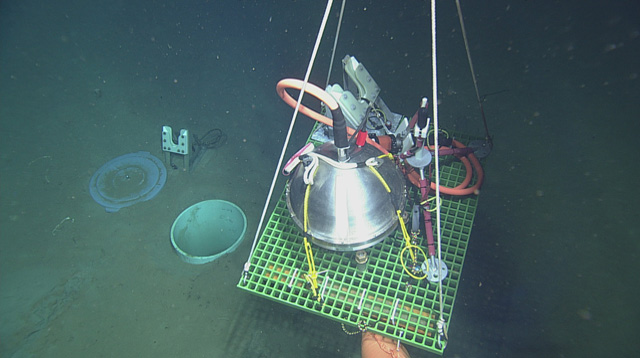19 April 2023–Earthquakes, lava bubbling through the sea floor and fin whale calls are all part of the noisy seismic environment at Axial Seamount, an active submarine volcano located about 480 kilometers west of Oregon’s Cannon Beach.
To identify the sources of all these seismic noises, Kaiwen Wang of Lamont-Doherty Earth Observatory and colleagues used machine learning techniques to sift through seven years’ worth of data collected near Axial by ocean-bottom seismometers, Wang said at the Seismological Society of America (SSA)’s 2023 Annual Meeting.
Axial Seamount sits at a complex intersection of an ocean spreading center between the Juan de Fuca and North American tectonic plates and a geological hotspot of upwelling magma, making its seismic and volcanic activity complicated to track and understand.
Some of the most intriguing seismic events uncovered by the researchers in the new seismic catalog were mixed-frequency earthquakes, which had never been seen in the area before, said Wang. These earthquakes first appeared a few hours before the 2015 eruption of Axial, which took place near the top of the magma chamber underlying the volcano.
Wang and colleagues were then able to trace these earthquakes as they migrated south along a ring fault and moved upward near where fresh lava was reaching the sea floor in the center of the volcanic caldera. The earthquakes may represent the brittle failure of the crust in response to magma moving prior to the eruption, she said.

An ocean bottom seismometer array was deployed at Axial Seamount in 2014, capturing the 2015 eruption just five months after it started operating. Wang and colleagues used a machine learning technique called an unsupervised learning algorithm to take a closer look at the seismic waveforms of Axial earthquakes captured by the array.
“Previous studies have focused on finding smaller earthquakes or better locating them,” said Wang. “However, there’s much more information than the earthquake locations or magnitudes embedded in their complex waveforms. The machine learning tools in this study enable us to extract detailed information from the seismic waveforms.”
The tools allowed the researchers to build “fingerprints” of each earthquake that include these distinct pieces of information, and then to cluster certain earthquakes together based on their fingerprints. “We demonstrate that with unsupervised learning, we could separate signals of different sources without knowing them beforehand,” said Wang.
The techniques uncovered signals from fin whale calls, seismic tremor, earthquakes and seafloor explosive events generated by lava, Wang said. “What surprised us is the machine learning methods work quite well in distinguishing various signals and finding subtle differences that humans would not notice.”
The researchers plan to examine the seismic clusters revealed in their study along with other geophysical measurements to further understand the mechanisms behind each seismic source. “This will ultimately improve our understanding of volcano dynamics and help us forecast Axial’s next eruption,” she said.
